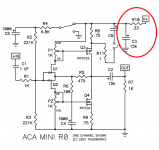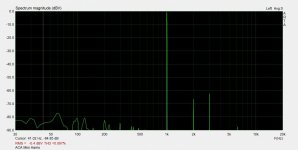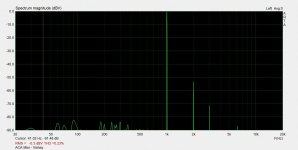I’ve been experimenting with the absolute cheapest PSU bricks I can find on Amazon and eBay, which are significantly cheaper than the (outstanding) MeanWell bricks.
Are the MeanWell better? Unquestionably. However, a breathtaking amount of nasty SMPS grunge on the cheap bricks can be cleaned up by the Mark Johnson designed PO89ZB inline filter doohickey. https://diyaudiostore.com/collections/power-supply-kits/products/smps-dc-filter-p089zb-kit
Lots of options out there to get these wonderful amplifiers built and playing beautiful music.
Are the MeanWell better? Unquestionably. However, a breathtaking amount of nasty SMPS grunge on the cheap bricks can be cleaned up by the Mark Johnson designed PO89ZB inline filter doohickey. https://diyaudiostore.com/collections/power-supply-kits/products/smps-dc-filter-p089zb-kit
Lots of options out there to get these wonderful amplifiers built and playing beautiful music.

It comes down to noise and ability to initially charge the caps. I cannot hear any noise with my ear against a 93 dB sensitive driver with the present filter/Meanwell, so we will see how it goes with new cheaper samples.
one question regarding Bias current on output MOSFETs. how do we come up with bias currents for a particular MOSFETs?
From the articles its given that higher Bias on MOSFETs better its linearity and sound output. Many of the class A amps have output bias of more than 1 amp or 1.2 amps. For example ACA amp have more than 1 amp of bias current on output MOSFET.
But for ACA Mini we have only 0.4 amps of bias current on output MOSFETs. Why do we have lesser bias current for ACA MINI ?
Is it because of push pull topology VS single ended MOSFET topology ?
Or is it because the IRF520 MOSFETs are low powered devices when compared with IRFP240 ?
From the articles its given that higher Bias on MOSFETs better its linearity and sound output. Many of the class A amps have output bias of more than 1 amp or 1.2 amps. For example ACA amp have more than 1 amp of bias current on output MOSFET.
But for ACA Mini we have only 0.4 amps of bias current on output MOSFETs. Why do we have lesser bias current for ACA MINI ?
Is it because of push pull topology VS single ended MOSFET topology ?
Or is it because the IRF520 MOSFETs are low powered devices when compared with IRFP240 ?
So its depends on output power we are targeting, like low output power amp we need to have lower bias current and high output amp we need to have high bias current on output MOSFETs..
Also its said like MOSFETs needs to be biased at higher currents for low distortion / linearity. So low power MOSFETs needs lower bias currents as in ACA MINI.
Also its said like MOSFETs needs to be biased at higher currents for low distortion / linearity. So low power MOSFETs needs lower bias currents as in ACA MINI.
Because it's a multi-role, multi-mission, widely applicable filter, PO89ZB is more expensive than what is required here.... why not incorporate the PO89ZB circuit right into the [DIY ACA mini] board? Jumper could be used to take it in and out of the circuit…even a switch for that matter (that would be fun)
PO89ZB is designed to deliver 3 amperes, but the DIY ACA mini only draws 1 amp (500mA per channel). PO89ZB is designed to operate at 48 volts, but the DIY ACA mini uses only 24 volts. PO89ZB is designed to have extremely low in-to-out voltage drop when 3 amps are flowing, but the DIY ACA mini can tolerate substantially more voltage drop while drawing one third of the current.
The single-component ($2.49) filtration idea in post #849 is cheaper and smaller, while providing a substantial improvement in HF attenuation compared to the stock DIY Mini ACA. In my opinion.
_
Attachments
From Nelson's ACA Mini Article:Why do we have lesser bias current for ACA MINI ?
Resistors P1 and P2 are potentiometers that will be adjusted to set the idle current of the output Mosfets at about 0.4 Amps, which is about 5 watts dissipation for each output device.
From the spec sheet for IRF9520 it show maximum dissipation of 60W. So the outputs transistors could handle an increase in bias but the byproduct is more heat. The smallish heat sinks run rather hot at 5 watts, so a higher bias would require larger sinks. But I'm not sure there would actually be a benefit to a higher bias on the ACA Mini.
Last edited:
don't use force, use a bigger hammer
so, if one want bigger amp than ACA Mini .... build bigger amp
so, if one want bigger amp than ACA Mini .... build bigger amp
could you please help with the understanding of MOSFET bias currents .. my understanding from the reading different amplifier info firstwatt articles , is that MOSFETs needs to be applied with high bias currents for better performance .. but here with ACA mini, output MOSFETs are working well with only 0.4 amps .. so, is it like high power MOSFETs needs to be biased higher and low power MOSFETs needs to be biased with lesser currents ?
Would you also sell just the matched JFET/MOSFET sets w/o other parts? That's all I really need or want. I made my own boards (I just populated and tested them yesterday and they work great) because that's what us addicted hobbyists do.I have arranged for the ACA Mini to be in the store shortly. The essentials kit will consist of pcb and semis and will be quite inexpensive. There will also be a completion kit which has the other parts. At the moment I am testing a cheaper power supply for it.
The remaining Harris parts are to be found at Rochester Electronics. I see a few hundred Harris irf520 and 9520 so maybe someone would like to organize a group buy.
The Essentials kit is pcb plus Mosfet and Jfets. As the board itself is quite cheap I suggest just buying that kit when it arrives.
DIY ACA Mini Input Impedance?
Hi everyone,
I got one of the ACA Mini Amp from the group buy from a few months ago, and it works great, but I was just gifted a PreAmp that suggest to use an Amp with a minimum of 20 k ohms of input impedance, does anyone knows what's the input impedance of it?
Thanks and cheers
Daniel
Hi everyone,
I got one of the ACA Mini Amp from the group buy from a few months ago, and it works great, but I was just gifted a PreAmp that suggest to use an Amp with a minimum of 20 k ohms of input impedance, does anyone knows what's the input impedance of it?
Thanks and cheers
Daniel
Below are measurements of two ACA mini's. One has a match pair of Harris MOSFETs, the other matched Vishay MOSFETs. The spectrum with the Harris transistors is about what I anticipated, but the Vishays are not what I was expecting. Why the big difference, even though all transistors have been matched?
Both measurements are with jumper in.
Both measurements are with jumper in.
Attachments
I wonder if the results would of been the same if you had use only one ACA mini and you had swapped the output devices.
Would be interesting to have a single ACA Mini equipped with the Vishay MOSFET on 1 channel and the Harris MOSFET on the other channel.
Sorry if I can’t help answering your question.
Would be interesting to have a single ACA Mini equipped with the Vishay MOSFET on 1 channel and the Harris MOSFET on the other channel.
Sorry if I can’t help answering your question.
So... how do you match the MOSFETs? Can you share the technique? That's something I should probably do.Below are measurements of two ACA mini's. One has a match pair of Harris MOSFETs, the other matched Vishay MOSFETs. The spectrum with the Harris transistors is about what I anticipated, but the Vishays are not what I was expecting. Why the big difference, even though all transistors have been matched?
Both measurements are with jumper in.
I just found this... Is this the way you use? https://www.firstwatt.com/pdf/art_matching.pdfSo... how do you match the MOSFETs? Can you share the technique? That's something I should probably do.
Thank you!
I don’t know what the phase of the 2nd harmonic is on the Vishays, but I will hazard a guess that they suffer from the classic "p channel IR issue" documented in my old article on testing mosfets, where the transconductance shelves down about 3 dB from the mid-band up. This is why we usually prefer the Harris parts. Try a test at 100 Hz.
- Home
- Amplifiers
- Pass Labs
- DIY ACA mini


